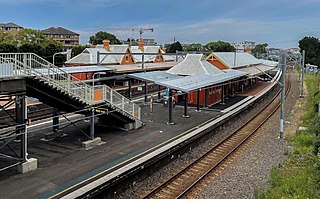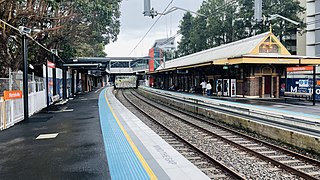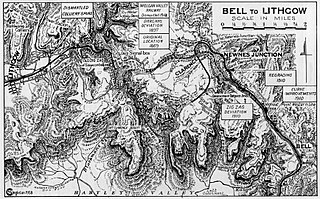
The South Coast Railway is a passenger and freight railway line from Sydney to Wollongong and Bomaderry in New South Wales, Australia. Beginning at the Illawarra Junction, the line services the Illawarra and South Coast regions of New South Wales.

Arncliffe railway station is a heritage-listed railway station located on the Illawarra line, serving the Sydney suburb of Arncliffe in Bayside Council. It is served by Sydney Trains' T4 Eastern Suburbs & Illawarra Line services. It was added to the New South Wales State Heritage Register on 2 April 1999.

Oatley railway station is a heritage-listed railway station located on the Illawarra line, in the Sydney suburb of Oatley in the Georges River Council local government area of New South Wales, Australia. The station is served by Sydney Trains' T4 Eastern Suburbs & Illawarra Line services. It was designed and built by the NSW Government Railway and from 1905 to 1992. It is also known as the Oatley Railway Station group. The property was added to the New South Wales State Heritage Register on 2 April 1999.

Otford is a village in the Otford Valley located 55 km south of the Sydney and 30 km north of the Wollongong CBD in New South Wales, Australia. Otford is within the local government area of the City of Wollongong.

Bulli railway station is a heritage-listed railway station on the South Coast railway line in New South Wales, Australia, serving the northern Wollongong suburb of Bulli. It was added to the New South Wales State Heritage Register on 30 August 2013.

Marrickville railway station is a heritage-listed railway station located on the Bankstown railway line, serving the Sydney suburb of Marrickville. It was added to the New South Wales State Heritage Register on 2 April 1999.

Dunmore railway station is a heritage-listed disused railway station located on the South Coast railway line in Dunmore, City of Shellharbour, New South Wales, Australia. The station served the southern Wollongong suburb of Dunmore and indirectly Shellharbour and opened on 9 November 1887. The weatherboard station on Platform 2 dates from 1887. It is also known as the Shellharbour Railway Station Group, Shellharbour railway station and Dunmore Railway Station. The property was added to the New South Wales State Heritage Register on 2 April 1999.

Albion Park railway station is a heritage-listed railway station located on the South Coast railway line on the Princes Highway in Albion Park Rail, New South Wales, Australia. The station was designed by New South Wales Government Railways and built during 1887 by William Monie & Company, with the single line railway line built by David Proudfoot and Thomas Logan. The complex is also known as the Albion Park Railway Station Group. The property was added to the New South Wales State Heritage Register on 2 April 1999. The station is located close to Shellharbour Airport.

Helensburgh railway station is a heritage-listed railway station located on the South Coast railway line in New South Wales, Australia. It serves the town of Helensburgh. It was added to the New South Wales State Heritage Register on 2 April 1999.

Scarborough railway station is a heritage-listed railway station on the South Coast railway line in New South Wales, Australia. It serves the seaside village of Scarborough. It was added to the New South Wales State Heritage Register on 2 April 1999.

Austinmer railway station is a heritage-listed railway station located on the South Coast railway line in New South Wales, Australia. It serves the northern Wollongong suburb of Austinmer. It was added to the New South Wales State Heritage Register on 2 April 1999.

Thirroul railway station is a heritage-listed railway station on the South Coast railway line in New South Wales, Australia. It serves the northern Wollongong suburb of Thirroul. It was added to the New South Wales State Heritage Register on 2 April 1999.

Helensburgh is a small town, located 45 kilometres (28 mi) south of Sydney and 35 kilometres (22 mi) north of Wollongong and north and above the Illawarra escarpment and region. Helensburgh is in the Wollongong City Council local government area. It is surrounded by bushland reserves adjacent to the southern end of the Royal National Park and Garawarra State Conservation Area and the Woronora reservoir water catchment is to its west.

The Ten Tunnels Deviation is a heritage-listed 9.2-kilometre (5.7 mi) section of the Main Western Line between Newnes Junction and Zig Zag stations in Lithgow, New South Wales, Australia. It was designed and built by the New South Wales Government Railways and built from 1 June 1908 and 16 October 1910. It is also known as Great Zig Zag Railway deviation tunnels and Bell to Zig Zag Ten Tunnel Railway Deviation. It was added to the New South Wales State Heritage Register on 2 April 1999.

Lilyvale railway station was a railway station on the South Coast railway line serving the small former village of Lilyvale, New South Wales, Australia.
Lilyvale is a locality in New South Wales on the northern periphery of the Wollongong local government area, south of Sydney. Most of the locality is now in the Royal National Park and Garawarra State Conservation Area. The former Lilyvale village centre, which at one stage had a population of about 200 people, was at Lilyvale railway station on the South Coast railway between Helensburgh and Otford.

Petersham Reservoir is a heritage-listed water reservoir at New Canterbury Road, Petersham, Inner West Council, Sydney New South Wales, Australia. It was designed and built by the New South Wales Public Works Department. It is also known as Petersham Service Reservoir and WS089. The property is owned by Sydney Water. It was added to the New South Wales State Heritage Register on 18 November 1999.

The Otford railway tunnel is a heritage-listed former railway tunnel on the Illawarra railway line at Otford, City of Wollongong, New South Wales, Australia. It was designed by the New South Wales Government Railways, and built by W. Rowe and W. Smith (tunnel) and Mr. McDonald. The property was added to the New South Wales State Heritage Register on 2 April 1999.

The Stanwell Creek railway viaduct is a heritage-listed railway bridge on the Illawarra railway line at Stanwell Park, City of Wollongong, New South Wales, Australia. It was designed by the New South Wales Government Railways and built in 1920 by day labour. The property is owned by Transport Asset Holding Entity, an agency of the Government of New South Wales. It was added to the New South Wales State Heritage Register on 2 April 1999.

The Metropolitan Tunnel, also known as Helensburgh Glow Worm Tunnel, is a disused rail tunnel in Helensburgh, New South Wales. It is a popular tourist attraction due to its glow worm population.




















